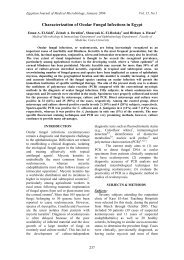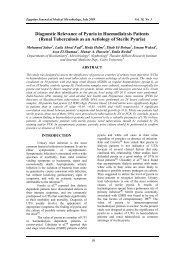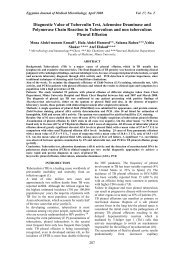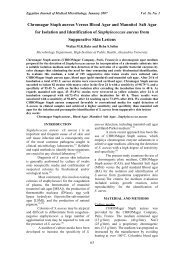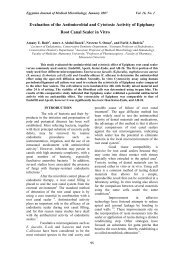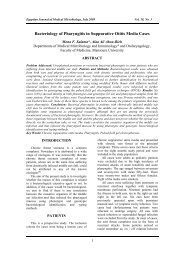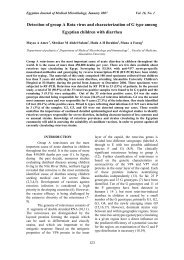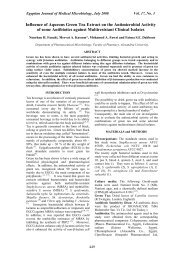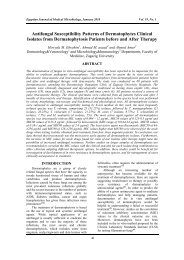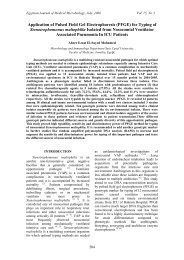Strain differentiation of Mycobacterium tuberculosis complex ...
Strain differentiation of Mycobacterium tuberculosis complex ...
Strain differentiation of Mycobacterium tuberculosis complex ...
Create successful ePaper yourself
Turn your PDF publications into a flip-book with our unique Google optimized e-Paper software.
Egyptian Journal <strong>of</strong> Medical Microbiology, January 2008 Vol. 17, No. 1<br />
Detection <strong>of</strong> hybridizing DNa was done by using<br />
chemiluminescent ECL (Amersham) detection kit.<br />
The 43-digit binary result is converted to a 15-<br />
digit octal designation as previously described<br />
(18).<br />
Table 1 Sequences <strong>of</strong> the oligonucleotides used in the study.<br />
Space Oligonucleotide sequence<br />
Space Oligonucleotide sequence<br />
No.<br />
No.<br />
1 ATAGAGGGTCGCCGGTTCTGGATCA 23 AGCATCGCTGATGCGTCCAGCTCG<br />
2 CCTCATAATTGGGCGACAGCTTTTG 24 CCGCCTGCTGGGTGAGACGTGCTCG<br />
3 CCGTGCTTCCAGTGATCGCCTTCTA 25 GATCAGCGACCACCGCACCCTGTCA<br />
4 ACGTCATACGCCGACCAATCATCAG 26 CTTCAGCACCACCATCATCCGGCGC<br />
5 TTTTCTGACCACTTGTGCGGGATTA 27 GGATTCGTGATCTCTTCCCGCGGAT<br />
6 CGTCGTCATTTCCGGCTTCAATTTC 28 TGCCCCGGCGTTTAGCGATCACAAC<br />
7 GAGGAGAGCGAGTACTCGGGGCTGC 29 AAATACAGCTCCACGACACGACCA<br />
8 CGTGAAACCGCCCCCAGCCTCGCCG 30 GGTTGCCCCGCGCCCTTTTCCAGCC<br />
9 ACTCGGAATCCCATGTGCTGACAGC 31 TCAGACAGGTTCGCGTCGATCAAGT<br />
10 TCGACACCCGCTCTAGTTGACTTCC 32 GACCAAATAGGTATCGGCGTGTTCA<br />
11 GTGAGCAACGGCGGCGGCAACCTGG 33 GACATGACGGCGGTGCCGCACTTGA<br />
12 ATATCTGCTGCCCGCCCGGGGAGAT 34 AAGTCACCTCGCCCACACCGTCGAA<br />
13 GACCATCATTGCCATTCCCTCTCCC 35 TCCGTACGCTCGAAACGCTTCCAAC<br />
14 GGTGTGATGCGGATGGTCGGCTCGG 36 CGAAATCCAGCACCACATCCGCAGC<br />
15 CTTGAATAACGCGCAGTGAATTTCG 37 CGCGAACTCGTCCACAGTCCCCCTT<br />
16 CGAGTTCCCGTCAGCGTCGTAAATC 38 CGTGGATGGCGGATGCGTTGTGCGC<br />
17 GCGCCGGCCCGCGCGGATGACTCCG 39 GACGATGGCCAGTAAATCGGCGTGG<br />
18 CATGGACCCGGGCGAGCTGCAGATG 40 CGCCATCTGTGCCTCATACAGGTCC<br />
19 TAACTGGCTTGGCGCTGATCCTGGT 41 GGAGCTTTCCGGCTTCTATCAGGTA<br />
20 TTGACCTCGCCAGGAGAGAAGATCA 42 ATGGTGGGACATGGACGAGCGCGAC<br />
21 TCGATGTCGATGTCCCAATCGTCGA 43 CGCAGAATCGCACCGGGTGCGGGAG<br />
22 ACCGCAGACGGCACGATTGAGACAA<br />
RESULTS<br />
MTC was cultured from sputum samples<br />
from 45 patients with a presumptive diagnosis <strong>of</strong><br />
pulmonary <strong>tuberculosis</strong> from Suez Canal region.<br />
All isolates contained IS6110 based upon PCR<br />
amplification <strong>of</strong> a 123-bp region <strong>of</strong> the insertion<br />
element. Among the 45 human isolates, one<br />
human isolate was determined to be M. bovis and<br />
44 were M. <strong>tuberculosis</strong> based upon amplification<br />
<strong>of</strong> 270- bp region <strong>of</strong> oxyR.<br />
Antimicrobial Susceptibility testing<br />
Twenty-5ive (56.8%) <strong>of</strong> the 44 MTB isolates<br />
were susceptible in vitro to all anti<strong>tuberculosis</strong><br />
drugs tested; 5 (11.4%) were mono-resistant to<br />
INH and STR (4 were resistant to STR and only<br />
one was resistant to INH); 14 (31.8%) were<br />
resistant to more than one drug (MDR). The 14<br />
MDR strains included 6 strains resistant to 4<br />
drugs, 3 resistant to INH, RIF, 3 resistant to INH<br />
and STR, one resistant to INH, RIF and EMB,<br />
and one resistant to INH, RIF and STR (Table 2).<br />
<strong>Strain</strong> types (IS6110 RFLP)<br />
Among the 44 MTB isolates tested for<br />
RFLP analysis in this study, 40 different RFLP<br />
patterns were obtained (table 3). The number <strong>of</strong><br />
IS6110 copies ranged from 5 to 16 (fig. 1).<br />
Studying the IS6110 RFLP patterns indicated that<br />
the 44 isolates did not cluster together but were<br />
generally scattered. Eight isolates were clustered<br />
together in 4 patterns, 2 isolates each. These two<br />
pairs <strong>of</strong> isolates had more than 90 % similarity but<br />
still had one difference in IS6110-hybridization<br />
band within each pair. The MDR-TB isolates did<br />
not cluster together.<br />
Spoligotyping<br />
Twenty-two different spoligotypes were<br />
identified among the 44 MTB isolates, <strong>of</strong> which<br />
13 were unique (Table 3). The remaining 31<br />
isolates (%) were grouped into 9 clusters <strong>of</strong> strains<br />
sharing identical spoligotypes. One <strong>of</strong> these<br />
clusters contained 12 isolates (%) and represented<br />
the most frequently observed type, which was<br />
designated as spoligotype A. The other major<br />
spoligotypes H & G, were observed for 4 (%) and<br />
3 (%) isolates respectively. While Spoligotypes C,<br />
E, I, K, M, and S were observed for 2 isolates<br />
(3.50%) (Fig. 2).<br />
145



